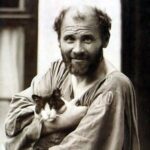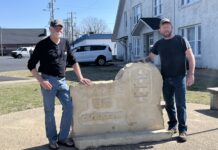Autumn in Carthage is art!
“All art is erotic,” declared the Austrian painter Gustav Klimt.
With the passing of autumn’s splendid apogee, I see and feel Klimt’s truth everywhere. Before shedding her frocks for her deep winter’s sleep, Mother Nature continues to dance in her quietly passionate celebration. The patchwork strokes of her brightly pigmented garments still paint the deciduous trees as colorful abstractions—the sensuous lines of charcoal tinted trunks and limbs lacing them together.
Looking out from our upstairs bedroom window, we see the last golden leaves dangling from the giant Sycamore tree across the street. Yes, Mother Nature is flirting with us, inviting our hearts to keep dancing with hers. Gustav Klimt saw her beckoning, too, heard her calling and took up her invitation.
On recent mornings I have thought often of Klimt and his art when our Aussie Lasyrenn and I headed out on her training walks going east. With the gentle sun stretching rich and golden across the spacious lawns of Central Park, we seemed to be striding into the atmosphere of a Klimt painting.
Together, my husband David and I have spoken often of Gustav Klimt as we have taken in the back road scenery while making our weekend junkets ferrying our puppies to the puppy park in Joplin. Driving through the autumn decorated streets of Carthage then out into the countryside; meandering over the familiar landscape we have seen the art of Klimt around every curve, over every hillock and in every view out every window. The color flecked rise and fall of the terrain echoed the rise and fall of the contours of a feminine body in repose. Again and again we have said, “This feels like a Klimt kind of day! This is a Klimt kind of season.”

Do you know of the artist Gustav Klimt? Are you familiar with his exquisite paintings romantically adorned with color and gold and women and beauty?
In Vienna in 1862, Gustav Klimt was born, the second of seven children in a lower middle-class family of Moravian origin. His father, Ernst Klimt, an engraver and goldsmith, earned very little money, and the artist’s childhood was spent in semi-poverty.
In 1876, at age fourteen Gustav Klimt received a scholarship to the Vienna School of Arts and Crafts. After completing his studies in 1883, his commissions for murals in public buildings carried him to the height of artistic fame. Becoming a fashionable, highly compensated portraitist Klimt began supporting his family of birth while he dramatically began turning toward Art Nouveau’s radical new styles incorporating Japanese, Chinese, Ancient Egyptian and Mycenaean art styles. Favoring decorative patterns, he painted beautiful women in elegant, flattering and languid poses.
Increasingly Klimt added an abundance of gold leaf in what became known as his Golden Phase. Perhaps you are familiar with his most well-known “golden” painting, “The Kiss”, which reflects the strong influence of the gold-detailed religious art of the Middle Ages, as well as the sacred works created by artists of the Byzantine Empire. Some critics considered such painting to be sacrilegious. Though many of Klimt’s paintings were destroyed by retreating German troops in World War II, “The Kiss” remains on exhibit at the Belvedere museum in Vienna.
The two embracing figures of “The Kiss”, depicted not naked, but draped in densely patterned cloths, are said to represent the mystical union of spiritual and erotic love and the merging of the individual with the eternal cosmos. They evoke a moment of intense sensual pleasure within a stylized composition—the masculine signified by a coat of black and gray blocks, the feminine represented as organic scrolling and spinning circles of bright floral motifs and upward flowing wavy lines. Golden rain surrounds them, blessing them and the fertile earth—the earth we now see celebrating all around us while making ready to rest.
At artCentral in this celebratory season you can find lovely hints of Klimt in the glittering reflections of metallic surfaces adeptly painted by artists Ina Niday and Mary Datum.
Come see their celebratory art in TWO FRIENDS | OIL PAINTINGS; and visit the SMALL WORKS | GREAT WONDERS Silent Auction Fundraiser. Both are available for your viewing, bidding and holiday shopping through December 5, at 1110 East Thirteenth Street in Carthage. Weekend Gallery Hours are each Friday and Saturday from 12:00 to 5:00 p.m. with CDC protocols practiced at Hyde House. All images are available online at www.artcentralcarthage.org. For additional information call (417) 358-4404.
















